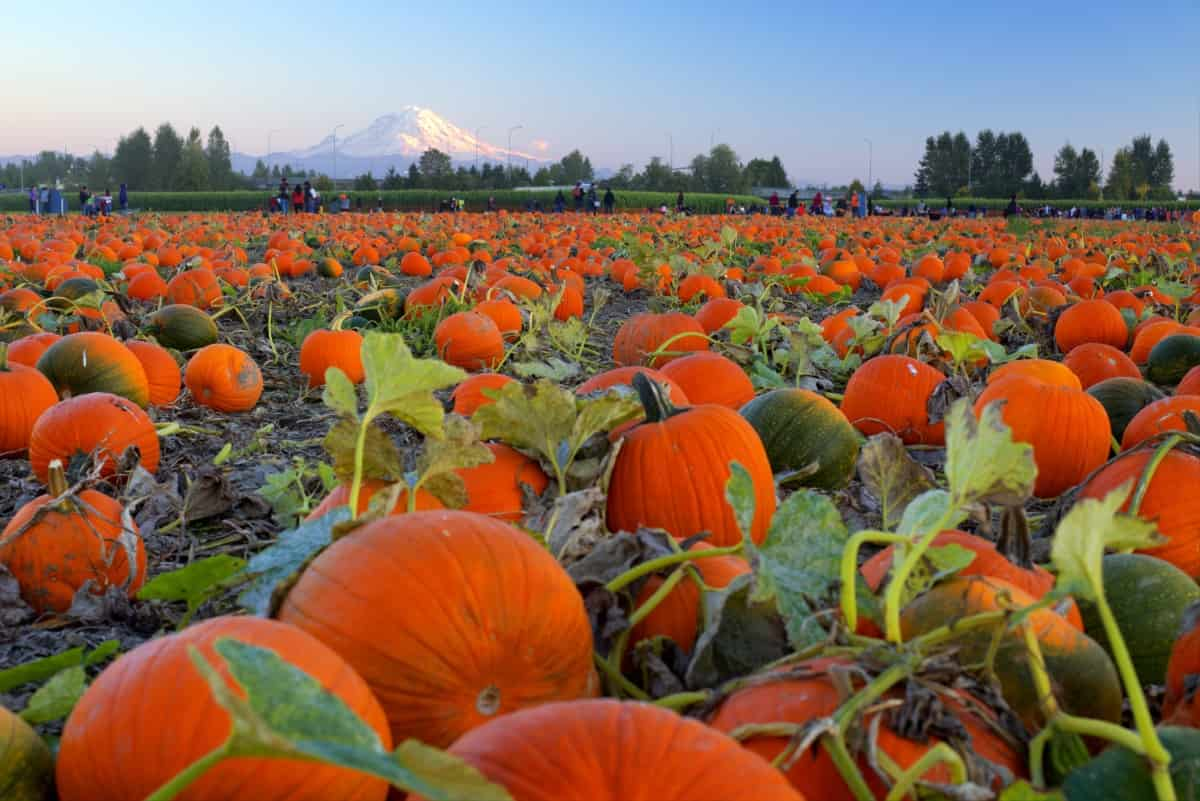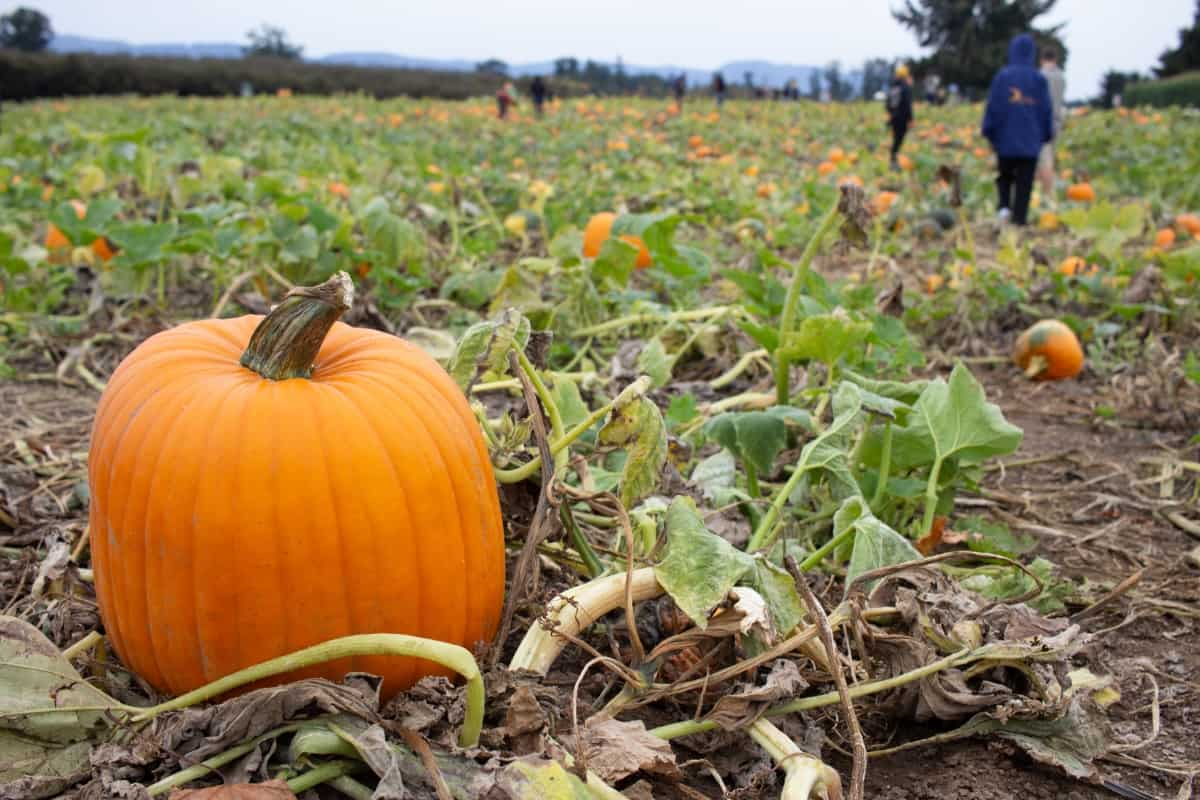Growing Pumpkins can be a rewarding experience when you implement these growth hacks into your gardening routine. With careful planning, you’ll soon have an abundance of Pumpkins ready for carving or enjoying delicious recipes.

How to Get More Pumpkins Per Plant
Start with Quality Seeds or Seedlings
When it comes to growing Pumpkins, starting with quality seeds or seedlings is essential for a successful harvest. First and foremost, look for seeds or seedlings from reputable sources. This ensures that you’re getting varieties specifically bred for optimal growth and yield. Additionally, reputable sources often prioritize quality control measures, resulting in healthier plants overall.
Next, consider the age of the seeds or transplants. Freshness is key when it comes to Pumpkin success. Older seeds may have lower germination rates, while older transplants might struggle to establish themselves in the garden. Some varieties are naturally more resistant to common Pumpkin diseases, such as powdery mildew or vine borers. Choosing disease-resistant varieties can save you time and effort down the line by reducing your risk of plant loss.
Provide Adequate Sunlight
One of the most important factors in growing healthy and productive Pumpkin plants is providing them with adequate sunlight. Pumpkins thrive in full sun, which means they need at least six to eight hours of direct sunlight each day. When choosing a location for your Pumpkin patch, make sure it receives ample sunlight throughout the day. Avoid areas that are shaded by tall trees or buildings, as this can decrease the growth and development of your Pumpkins.
If you have limited space in your garden or if there are shading issues, consider using reflective materials like aluminum foil or white plastic mulch to redirect and maximize the amount of sunlight reaching your plants. In addition to providing enough sun exposure, it’s also crucial to ensure proper air circulation around your Pumpkin plants.
Choose the Right Location and Soil
Choosing the right place and soil is key for growing healthy and productive Pumpkin plants. When selecting a location, make sure it receives 6-8 hours of direct sunlight daily. Pumpkins thrive in warm weather, so choose a place that receives enough sun throughout the day. In terms of soil, Pumpkins prefer well-drained soil with a pH between 6.0 and 7.5. Avoid planting Pumpkins in low-lying areas where water tends to pool or where there is poor air circulation. These conditions can lead to fungal diseases and rotting issues.
Plant at the Right Time with Proper Spacing
When planting Pumpkins, timing is everything. To get the most out of your Pumpkin plants and maximize your yield, it’s crucial to plant them at the right time and provide them with proper spacing. Pumpkins thrive in warm weather, so before planting wait until all danger of frost has passed. This is typically around late spring or early summer. By waiting for the optimal temperature range of 21-29°C, you give your Pumpkins a better chance of germinating successfully.
In case you missed it: How to Deal with Pumpkin Pests: Getting Rid of them with Natural, Organic, and Homemade Recipes

Once you’ve determined the right time to plant, it’s important to consider proper spacing. Pumpkin plants require ample room for their sprawling vines and large leaves. Aim for a spacing of about 4-6 feet between each hill or mound where you’re planting your seeds or seedlings.
Mulch and Water Pumpkin Plants Regularly
Mulching and providing regular water to Pumpkin plants are crucial factors for achieving a high yield. Mulching helps retain moisture, suppress weed growth, maintain soil temperature, and prevent soil erosion. It acts as a protective layer around the plant’s roots, keeping them cool during hot summer days.
When it comes to choosing the right mulch for Pumpkins, organic options like straw or compost work best. Watering is another essential aspect of Pumpkin plant care. Consistent watering ensures that the plants receive adequate moisture throughout their growing season. As a rule of thumb, Pumpkins need about 1-2 inches of water per week.
Prune or Trim and Support for Optimal Growth
Pruning or trimming and providing support to your Pumpkin plants can significantly enhance their growth and yield. Regular pruning allows its energy to focus on producing more Pumpkins rather than sprawling vines. It also improves air circulation around the plants, reducing the risk of diseases. When pruning, remove any damaged or dead leaves and vines. This will prevent them from sapping nutrients that could otherwise be used for Pumpkin production. Additionally, trim back excessive foliage to enable sunlight penetration into every part of the plant.
Supporting your Pumpkin plants is equally important. As they grow, their heavy fruits can put a strain on the vines and may cause them to break or detach from the main stem. Using trellises or cages provides a sturdy structure for supporting these fruits while ensuring proper airflow. To support your Pumpkin plants effectively, place a mesh netting beneath each fruit as soon as it starts forming. This will distribute weight evenly across multiple points along the vine and minimize stress on individual sections.
Apply Best Fertilizers to Produce More Pumpkins
Fertilizing your Pumpkin plants is crucial for achieving a bountiful harvest. By providing the right nutrients, you can help your Pumpkins grow larger and healthier. Consider using organic fertilizers like compost or well-rotted manure. Additionally, look for fertilizers specifically formulated for vegetables or fruit-bearing plants. These products usually contain a balanced blend of macronutrients, which are vital for plant growth. When applying fertilizer, you should follow the instructions on the package carefully. Over-fertilization causes excessive foliage growth at the expense of fruit production.
Monitor and Control for Pests and Diseases
Pumpkins, like any plant, are susceptible to pests and diseases. To ensure a high yield, it’s essential to monitor and control these issues effectively. One common pest that affects Pumpkins is the squash bug. These critters can cause significant damage if left unchecked. If you spot them early on, manually remove them or use organic insecticides to keep their population in check.
Another pesky problem is powdery mildew, a fungal disease that can hinder Pumpkin growth. Keep an eye out for white powdery patches on the leaves and stems. To prevent its spread, space your plants adequately for proper air circulation and avoid overhead watering. Root rot can also affect Pumpkin plants. This condition occurs due to waterlogged soil, causing the roots to decay. Ensure good drainage in your garden beds by adding compost or peat moss before planting.
In case you missed it: Growing Pumpkins from Seed to Harvest: A Detailed Guide for Beginners

Aphids suck sap from plant tissues and transmit viruses in the process. They reproduce rapidly, so it’s important to catch them early on when their population is still manageable. Use insecticidal soap as a natural remedy to control aphids. Cucumber beetles are yet another nuisance when it comes to Pumpkin cultivation. Covering your plants with row covers during vulnerable stages can help protect them from these beetles’ destructive feeding habits.
Carryout Hand Pollination in Case of Poor Pollination
Pollination plays a key role in the growth and development of Pumpkins. However, sometimes, nature needs a helping hand to ensure successful pollination. If you notice poor pollination or lack of fruit set in your Pumpkin plants, it’s time to consider hand pollination. Hand pollination involves transferring pollen from the male flower to the female flower manually. To do this, simply identify a male flower with a long stem and no swelling at the base (this is where the fruit would grow). Gently remove one of its petals to expose the stamen covered in yellow pollen.
Next, locate a female flower with a small swelling at its base (the future Pumpkin). Take care not to damage any part of either flower during this process. Using a cotton swab, gently transfer some pollen from the male flower onto the stigma inside the female flower. Repeat this process for other flowers as needed, ensuring each female bloom receives sufficient pollen for fertilization. It’s important to conduct hand pollination early in the morning when both male and female flowers are fully open.
Increase Flowering in Pumpkins for More Yield
One of the key factors in getting a high yield of Pumpkins is ensuring that your plants produce plenty of flowers. The more flowers you have, the greater the chance of pollination and fruit development. Make sure your plants receive enough sunlight. Pumpkins thrive in full sun, so choose a place that receives at least 6-8 hours of direct sunlight each day. This will encourage healthy growth and abundant flower production.
Next, provide adequate water to keep your Pumpkin plants hydrated. Water them regularly, but avoid overwatering as this can cause root rot and other problems. A consistent moisture level is essential for promoting flowering. Additionally, consider using organic fertilizers rich in phosphorus and potassium to stimulate flower production. These nutrients play a crucial role in encouraging plant growth and blooming.
Make Sure to Harvest at the Right Time
Timing is crucial when harvesting Pumpkins. You want to make sure that you pick them at their peak ripeness for the best flavor and longevity. Pay attention to the color of the Pumpkin. As they mature, they will start changing from green to a deeper orange or whatever color variety you are growing. This is a good indicator that they are ready for harvest. Check the skin of the Pumpkin. It should be hard rather than soft or easily punctured. A firm skin ensures that your Pumpkins have reached their full potential.
In case you missed it: Best Fertilizer for Pumpkin: Homemade, Organic, Liquid, Compost Manure, NPK, and Schedule

Another important factor is checking if the stem has dried out and turned brown. If this is the case, then it means your Pumpkin has detached itself from its vine and is ready for picking. When harvesting, use sharp tools like pruning shears or a knife to carefully cut off each Pumpkin from its vine without damaging it. Leave about 3-4 inches of stem attached, as this helps with storage and prevents rotting.
Conclusion
Growing Pumpkins can be an enjoyable experience, especially when you see the fruits of your labor in the form of large, vibrant Pumpkins. By implementing these Pumpkin growth hacks, you can maximize your yield and produce an abundant harvest.
- How to Grow Tomatoes Organically at Home: A Comprehensive Guide
- Organic Gardening on a Budget: Low-Cost Methods and Materials
- Gongura Seed Germination and Planting Methods
- Cabbage Seed Germination and Selection
- Broccoli Seed Germination and Selection
- Asparagus Seed Germination and Variety Selection
- Seasonal Flower Gardening: Best Practices for Spring, Summer, Fall, and Winter
- How to Grow Hibiscus from Flower
- Plantation Ideas for Home Decoration: A Beginners Guide